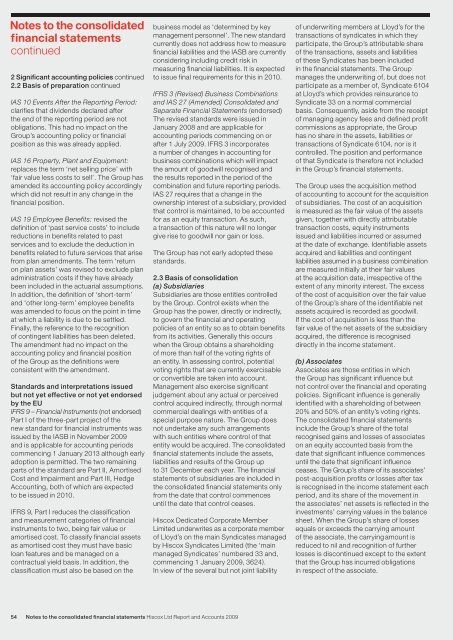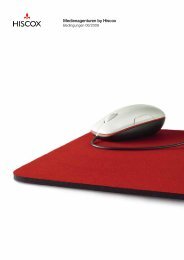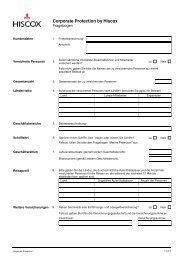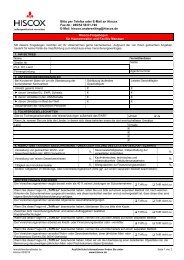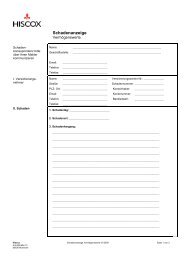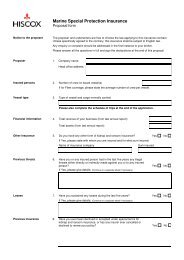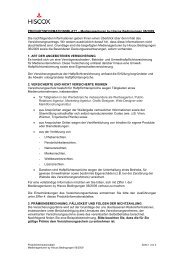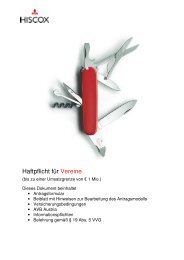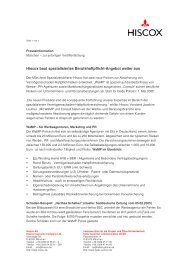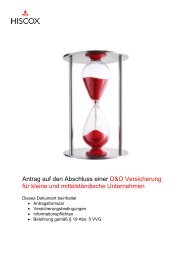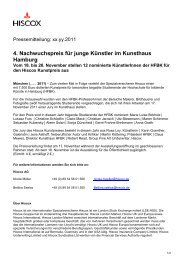Download PDF - Hiscox
Download PDF - Hiscox
Download PDF - Hiscox
You also want an ePaper? Increase the reach of your titles
YUMPU automatically turns print PDFs into web optimized ePapers that Google loves.
Notes to the consolidated<br />
financial statements<br />
continued<br />
2 Significant accounting policies continued<br />
2.2 Basis of preparation continued<br />
IAS 10 Events After the Reporting Period:<br />
clarifies that dividends declared after<br />
the end of the reporting period are not<br />
obligations. This had no impact on the<br />
Group’s accounting policy or financial<br />
position as this was already applied.<br />
IAS 16 Property, Plant and Equipment:<br />
replaces the term ‘net selling price’ with<br />
‘fair value less costs to sell’. The Group has<br />
amended its accounting policy accordingly<br />
which did not result in any change in the<br />
financial position.<br />
IAS 19 Employee Benefits: revised the<br />
definition of ‘past service costs’ to include<br />
reductions in benefits related to past<br />
services and to exclude the deduction in<br />
benefits related to future services that arise<br />
from plan amendments. The term ‘return<br />
on plan assets’ was revised to exclude plan<br />
administration costs if they have already<br />
been included in the actuarial assumptions.<br />
In addition, the definition of ‘short-term’<br />
and ‘other long-term’ employee benefits<br />
was amended to focus on the point in time<br />
at which a liability is due to be settled.<br />
Finally, the reference to the recognition<br />
of contingent liabilities has been deleted.<br />
The amendment had no impact on the<br />
accounting policy and financial position<br />
of the Group as the definitions were<br />
consistent with the amendment.<br />
Standards and interpretations issued<br />
but not yet effective or not yet endorsed<br />
by the EU<br />
IFRS 9 – Financial Instruments (not endorsed)<br />
Part I of the three-part project of the<br />
new standard for financial instruments was<br />
issued by the IASB in November 2009<br />
and is applicable for accounting periods<br />
commencing 1 January 2013 although early<br />
adoption is permitted. The two remaining<br />
parts of the standard are Part II, Amortised<br />
Cost and Impairment and Part III, Hedge<br />
Accounting, both of which are expected<br />
to be issued in 2010.<br />
IFRS 9, Part I reduces the classification<br />
and measurement categories of financial<br />
instruments to two, being fair value or<br />
amortised cost. To classify financial assets<br />
as amortised cost they must have basic<br />
loan features and be managed on a<br />
contractual yield basis. In addition, the<br />
classification must also be based on the<br />
business model as ‘determined by key<br />
management personnel’. The new standard<br />
currently does not address how to measure<br />
financial liabilities and the IASB are currently<br />
considering including credit risk in<br />
measuring financial liabilities. It is expected<br />
to issue final requirements for this in 2010.<br />
IFRS 3 (Revised) Business Combinations<br />
and IAS 27 (Amended) Consolidated and<br />
Separate Financial Statements (endorsed)<br />
The revised standards were issued in<br />
January 2008 and are applicable for<br />
accounting periods commencing on or<br />
after 1 July 2009. IFRS 3 incorporates<br />
a number of changes in accounting for<br />
business combinations which will impact<br />
the amount of goodwill recognised and<br />
the results reported in the period of the<br />
combination and future reporting periods.<br />
IAS 27 requires that a change in the<br />
ownership interest of a subsidiary, provided<br />
that control is maintained, to be accounted<br />
for as an equity transaction. As such,<br />
a transaction of this nature will no longer<br />
give rise to goodwill nor gain or loss.<br />
The Group has not early adopted these<br />
standards.<br />
2.3 Basis of consolidation<br />
(a) Subsidiaries<br />
Subsidiaries are those entities controlled<br />
by the Group. Control exists when the<br />
Group has the power, directly or indirectly,<br />
to govern the financial and operating<br />
policies of an entity so as to obtain benefits<br />
from its activities. Generally this occurs<br />
when the Group obtains a shareholding<br />
of more than half of the voting rights of<br />
an entity. In assessing control, potential<br />
voting rights that are currently exercisable<br />
or convertible are taken into account.<br />
Management also exercise significant<br />
judgement about any actual or perceived<br />
control acquired indirectly, through normal<br />
commercial dealings with entities of a<br />
special purpose nature. The Group does<br />
not undertake any such arrangements<br />
with such entities where control of that<br />
entity would be acquired. The consolidated<br />
financial statements include the assets,<br />
liabilities and results of the Group up<br />
to 31 December each year. The financial<br />
statements of subsidiaries are included in<br />
the consolidated financial statements only<br />
from the date that control commences<br />
until the date that control ceases.<br />
<strong>Hiscox</strong> Dedicated Corporate Member<br />
Limited underwrites as a corporate member<br />
of Lloyd’s on the main Syndicates managed<br />
by <strong>Hiscox</strong> Syndicates Limited (the ‘main<br />
managed Syndicates’ numbered 33 and,<br />
commencing 1 January 2009, 3624).<br />
In view of the several but not joint liability<br />
54 Notes to the consolidated financial statements <strong>Hiscox</strong> Ltd Report and Accounts 2009<br />
of underwriting members at Lloyd’s for the<br />
transactions of syndicates in which they<br />
participate, the Group’s attributable share<br />
of the transactions, assets and liabilities<br />
of these Syndicates has been included<br />
in the financial statements. The Group<br />
manages the underwriting of, but does not<br />
participate as a member of, Syndicate 6104<br />
at Lloyd’s which provides reinsurance to<br />
Syndicate 33 on a normal commercial<br />
basis. Consequently, aside from the receipt<br />
of managing agency fees and defined profit<br />
commissions as appropriate, the Group<br />
has no share in the assets, liabilities or<br />
transactions of Syndicate 6104, nor is it<br />
controlled. The position and performance<br />
of that Syndicate is therefore not included<br />
in the Group’s financial statements.<br />
The Group uses the acquisition method<br />
of accounting to account for the acquisition<br />
of subsidiaries. The cost of an acquisition<br />
is measured as the fair value of the assets<br />
given, together with directly attributable<br />
transaction costs, equity instruments<br />
issued and liabilities incurred or assumed<br />
at the date of exchange. Identifiable assets<br />
acquired and liabilities and contingent<br />
liabilities assumed in a business combination<br />
are measured initially at their fair values<br />
at the acquisition date, irrespective of the<br />
extent of any minority interest. The excess<br />
of the cost of acquisition over the fair value<br />
of the Group’s share of the identifiable net<br />
assets acquired is recorded as goodwill.<br />
If the cost of acquisition is less than the<br />
fair value of the net assets of the subsidiary<br />
acquired, the difference is recognised<br />
directly in the income statement.<br />
(b) Associates<br />
Associates are those entities in which<br />
the Group has significant influence but<br />
not control over the financial and operating<br />
policies. Significant influence is generally<br />
identified with a shareholding of between<br />
20% and 50% of an entity’s voting rights.<br />
The consolidated financial statements<br />
include the Group’s share of the total<br />
recognised gains and losses of associates<br />
on an equity accounted basis from the<br />
date that significant influence commences<br />
until the date that significant influence<br />
ceases. The Group’s share of its associates’<br />
post-acquisition profits or losses after tax<br />
is recognised in the income statement each<br />
period, and its share of the movement in<br />
the associates’ net assets is reflected in the<br />
investments’ carrying values in the balance<br />
sheet. When the Group’s share of losses<br />
equals or exceeds the carrying amount<br />
of the associate, the carrying amount is<br />
reduced to nil and recognition of further<br />
losses is discontinued except to the extent<br />
that the Group has incurred obligations<br />
in respect of the associate.


